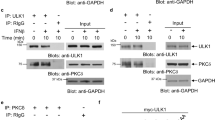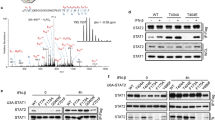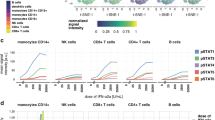Abstract
MANY human lymphoblastoid cells produce low levels of interferon spontaneously1–5 and this has been attributed to the presence of the Epstein—Barr virus (EBV) in such cells6–7. No clear relationship has been established, however, between the presence of EBV and spontaneous interferon production8. Since the latent EBV genome contained in human lymphoblastoid cells can be activated by treatment of these cells with halogenated pyrimidines9,10 or inhibitors of protein synthesis11 we determined the effect of 5-bromodeoxyuridine (BrdU) on interferon production in these cells in relation to the induction of EBV. Previous studies on the effect of halogenated pyrimidines on interferon production have yielded conflicting results ranging from no effect12–14 to inhibition15, or slight stimulation15,16. We report here that BrdU markedly increases both spontaneous and virus-induced interferon production in three human lymphoblastoid cell lines, without any apparent correlation with EBV induction.
This is a preview of subscription content, access via your institution
Access options
Subscribe to this journal
Receive 51 print issues and online access
$199.00 per year
only $3.90 per issue
Buy this article
- Purchase on Springer Link
- Instant access to full article PDF
Prices may be subject to local taxes which are calculated during checkout
Similar content being viewed by others
References
Henle, G. & Henle, W. J. Bact. 89, 252–258 (1965).
Zajac, B. A., Henle, W. & Henle, G. Cancer Res. 29, 1467–1475 (1969).
Swart, B. E. & Young, B. G. J. natn. Cancer Inst. 42, 941–944 (1969).
Adams, A., Lidin, B., Strander, H. & Cantell, K. J. gen. Virol. 28, 219–223 (1975).
Lidin, B. & Adams, A. Intervirology 5, 205–215 (1975).
Epstein, M. A., Barr, Y. M. & Achong, B. G. Wistar Inst. Symp. Monograph 4, 69–82 (1965).
Henle, G. & Henle, W. Cancer Res. 27, 2442–2446 (1967).
Oxman, M. N. in Interferons and Interferon Inducers (ed. Finter, N. B.) 424–427 (North-Holland, Amsterdam, 1973).
Hampar, B., Derge, J. G., Martos, L. M. & Walker, J. L. Proc. natn. Acad. Sci. U.S.A. 69, 78–82 (1972).
Gerber, P. Proc. natn. Acad. Sci. U.S.A. 69, 83–85 (1972).
Hampar, B., Lenoir, G., Nonoyama, M., Derge, J. G. & Chang, S. Y. Virology 69, 660–668 (1976).
Levy, H. B., Axelrod, D. & Baron, S. Proc. Soc. exp. Biol. Med. 118, 1013–1014 (1965).
Coppey, J. & Muel, B. Int. J. radiat. Biol. 17, 431–437 (1970).
Holmes, A. W., Gilson, J. & Deinhardt, F. Virology 24, 229–232 (1964).
Donikian, M. A. & Stewart, R. C. Bact. Proc. Abstr. 157, 144 (1964).
Swetly, P. J. Virol. 17, 27–32 (1976).
Lockart, R. Z. in Interferons and Interferon Inducers (ed. Finter, N. B.) 11–27 (North-Holland, Amsterdam, 1973).
Nyormoi, O., Klein, G., Adams, A. & Dombos, L. Int. J. Cancer 12, 396–408 (1973).
Klein, G. & Dombos, L. Int. J. Cancer 11, 327–337 (1973).
Teich, N., Lowy, D. R., Hartley, J. W. & Rowe, W. P. Virology 51, 163–173 (1973).
Hampar, B. et al. Nature new Biol. 244, 214–217 (1973).
Hampar, B., Tanaka, A., Nonoyama, M. & Derge, J. Proc. natn. Acad. Sci. U.S.A. 71, 631–633 (1974).
Pritchett, R., Pedersen, M. & Kieff, E. Virology 74, 227–231 (1976).
Klein, G. et al. Proc. natn. Acad. Sci. U.S.A. 71, 3283–3286 (1974).
Schwenk, H. U. & Schneider, U. Blut. 31, 299–306 (1975).
Price, P. M. Biochim. biophys. Acta. 447, 304–311 (1976).
Stellwagen, R. H. & Tomkins, G. M. Proc. natn. Acad. Sci. U.S.A. 68, 1147–1150 (1971).
Heller, E. Virology 21, 652–656 (1963).
Ng, M. H. & Vilcek, J. Adv. Protein Chem. 26, 209–234 (1972).
Strander, H., Mogensen, K. E. & Cantell, K. J. clin. Microbiol. 1, 116–117 (1975).
Tovey, M. G., Begon-Lours, J. & Gresser, I. Proc. Soc. exp. Biol. Med. 146, 809–815 (1974).
Gresser, I., Bandu, M. T., Brouty-Boye, D. & Tovey, M. G. Nature 251, 543–545 (1974).
Author information
Authors and Affiliations
Rights and permissions
About this article
Cite this article
TOVEY, M., BEGON-LOURS, J., GRESSER, I. et al. Marked enhancement of interferon production in 5-bromodeoxyuridine treated human lymphoblastoid cells. Nature 267, 455–457 (1977). https://doi.org/10.1038/267455a0
Received:
Accepted:
Issue Date:
DOI: https://doi.org/10.1038/267455a0
This article is cited by
-
Point Mutation Approach to Reduce Antigenicity of Interferon Beta
International Journal of Peptide Research and Therapeutics (2020)
-
Expression of the genes of interferons and other cytokines in normal and diseased tissues of man
Experientia (1989)
-
Factors affecting the CEA secretion of human adenocarcinoma cell lines into the spent medium
Gastroenterologia Japonica (1983)
-
Spontaneous production of ?- and ?-interferon in human lymphoblastoid and lymphoma cell lines
Archives of Virology (1982)
-
Interferon production and virus replication in lymphoblastoid cells infected with different viruses
Archives of Virology (1980)
Comments
By submitting a comment you agree to abide by our Terms and Community Guidelines. If you find something abusive or that does not comply with our terms or guidelines please flag it as inappropriate.



